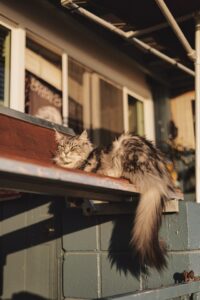Keeping Your Cat Safe: Preventing Escapes from the House

Cats are curious creatures with a natural inclination to explore their surroundings. While it’s important to allow them some outdoor time, it’s equally crucial to keep them safe within the confines of your home. Preventing your cat from attempting to escape is essential to avoid the risks associated with outdoor environments, such as accidents, exposure to diseases, and encounters with predators. In this article, we will discuss effective strategies to prevent your cat from trying to escape and provide them with a safe and enriching indoor environment.
Understanding the Reasons Behind Escape Attempts:
To effectively address your cat’s escape attempts, it’s crucial to understand the motivations behind their behavior. Some common reasons include:
- Curiosity: Cats have a natural instinct to explore new territories, which can lead them to seek opportunities to escape and satisfy their curiosity.
- Boredom and Stimulation: Cats require mental and physical stimulation to thrive. If they are not adequately engaged within the home, they may attempt to escape in search of excitement.
- Hormonal Urges: Unneutered or unspayed cats may be driven by hormonal instincts, particularly if there are intact males or females in the vicinity.
Strategies to Prevent Your Cats Escaping:
Secure Doors and Windows:
Ensure all doors and windows are securely closed and latched at all times. Install sturdy screens on windows to allow fresh air while preventing your cat from pushing through or climbing out. Consider using window locks or window stoppers to limit the opening space.
How to secure your place so your cat does not escape. Ensuring the security of doors and windows is essential to prevent your cat from escaping and keeping them safe within your home. Cats are agile and resourceful creatures, so taking proactive measures to secure these entry points is crucial. Here are some effective strategies to help you secure doors and windows for your feline friend:
- Install Sturdy Screens: Adding window screens is an excellent way to provide fresh air while keeping your cat safely inside. Opt for sturdy screens made of pet-friendly materials that can withstand your cat’s attempts to push through or claw at them.
- Use Window Locks and Stoppers: Window locks and stoppers are valuable tools to limit the opening space of windows. They prevent your cat from pushing the window wide open or squeezing through small gaps. Install these devices to ensure your cat cannot escape through partially opened windows.
- Reinforce Door and Window Frames: Check the integrity of door and window frames, ensuring there are no gaps or loose fittings that your cat can exploit. Reinforce any weak spots to eliminate potential escape routes.
- Utilize Childproof Latches: Childproof latches or locks can be employed on doors and windows to prevent your cat from pawing or nudging them open. These latches require dexterity to operate, making it difficult for cats to manipulate them and escape.
- Consider Pet-Friendly Window Coverings: Some cats are attracted to windows and may attempt to jump through glass panes. Consider using window coverings like blinds or curtains that your cat cannot easily push through or damage.
- Create a Buffer Zone: Establish a designated area near doors and windows that acts as a buffer zone for your cat. Place furniture or shelving units near these entry points, creating an obstacle that discourages your cat from reaching the doors or windows.
- Monitor High-Traffic Areas: Keep a close eye on doors and windows during periods of increased activity, such as when guests arrive or during home renovations. Ensure that doors are properly closed and windows are secured to prevent accidental escapes.
By implementing these measures, you can significantly reduce the risk of your cat escaping through doors and windows. Remember, vigilance is key when it comes to ensuring your cat’s safety indoors. Regularly inspect the security of these entry points and make adjustments as necessary to provide a secure and protected environment for your feline companion.

Create an Enriched Indoor Environment:
Provide a stimulating environment within your home to minimize your cat’s desire to explore outside. Consider the following:
- Vertical Space: Cats enjoy climbing and perching. Install cat trees, shelves, or wall-mounted climbing structures to provide them with vertical space and an opportunity to exercise.
- Scratching Posts: Satisfy your cat’s natural scratching instincts by offering sturdy scratching posts or boards. This will prevent them from attempting to escape to find alternative scratching surfaces outdoors.
- Interactive Toys: Engage your cat with interactive toys that stimulate their hunting instincts. Puzzle feeders, treat-dispensing toys, and feather wands can provide mental and physical stimulation.
- Window Perches: Set up window perches or secure cat shelves near windows, allowing your cat to observe the outside world without the risk of escape.
- Cat tree: Be nice for your cat since it could play and have a high ground, some have scratching areas to.

Neuter or Spay Your Cat:
If your cat is not already neutered or spayed, consider having the procedure done. This can significantly reduce their instinctual drive to escape in search of a mate.
Safe Outdoor Access:
Consider providing a safe outdoor environment for your cat to explore, such as a securely enclosed catio or a supervised outdoor enclosure. These structures allow your cat to experience the outdoors while ensuring their safety.
Positive Reinforcement:
Reward your cat for good behavior and reinforce their positive association with staying indoors. Use treats, praise, and playtime to reward them when they resist the urge to escape or exhibit desirable behaviors within the house.
Regular Exercise and Playtime:
Ensure your cat receives ample physical and mental stimulation through interactive play sessions. Use wand toys, laser pointers, or feather toys to engage them in play, promoting exercise and mental engagement.

Conclusion:
Preventing your cat from attempting to escape from the house requires a combination of strategies that provide a stimulating indoor environment while ensuring their safety. By securing doors and windows, creating an enriched indoor space, providing safe outdoor access when possible, and reinforcing positive behavior, you can minimize the risk of escape and keep your feline friend content and protected within the comfort of your home. Remember, each cat is unique, so observe their behavior, adjust the environment accordingly, and shower them with love and attention to create a fulfilling and secure indoor lifestyle.

